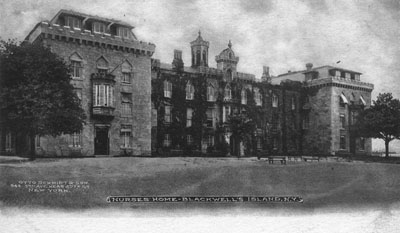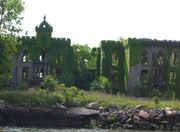
Smallpox Hospital (Renwick Ruin)
Landmarks Main > Smallpox Hospital (Renwick Ruin)
 Smallpox
Hospital (Renwick Ruin)
Smallpox
Hospital (Renwick Ruin)
On November 25, 1975, the Landmarks Preservation Commission held a public hearing on the proposed designation as a Landmark of the Chapel of the Good Shepherd and the proposed designation of the related Landmark Site. The hearing has been duly advertised in accordance with the provisions of law. Three witnesses spoke in favor of designation. There were no speakers in opposition to designation. The representatives of the Roosevelt Island Development Corporation have agreed to the designation.
Description and Analysis
Located a the southern tip of Roosevelt Island, this fine Gothic Revival structure was originally constructed for the treatment of that "loathsome malady," smallpox, and for many years was New York City's only such institution. It is now a picturesque ruin, one which could readily serve as the setting for a 19th century "Gothic" romance.
The construction of a new hospital was under consideration in 1850, at which time smallpox victims were cared for in what Resident Physician William Kelly described as "a pile of poor wooden out houses on the banks of the river." Unlike numerous other medical institutions built by the city on the island in the 19th century, the Smallpox Hospital was not planned exclusively for charity cases. Because of the seriousness and the contagious nature of the disease paying patients were also admitted. Although vaccination against smallpox was common medical practice by the mid-19th century, the disease continued to plague New York city. Smallpox often afflicted recently arrived immigrants, and therefore increasingly more stringent quarantine measures were instituted. As late as 1871 smallpox reached epidemic proportions in new York, while during the Civil War many soldiers as well as immigrants, were stricken with the disease.
The original Smallpox Hospital - without the north and south wings which are later additions -- was built in 1854-56 and designed by James Renwick, Jr. It was first opened for public inspection on December 18, 1856. When the old buildings were destroyed by fire, patients had to be transferred to the new hospital which was not yet completely ready. Nevertheless, the Resident Physician, William Sanger, reported that the new building was "admirable," and opinion also voiced by the professional staff during the following years. The Smallpox Hospital accommodated one hundred patients with charity cases in wards on the lower floors and a series of private rooms a the upper stories for paying patients. In 1875 the Board of Health assumed control of the Smallpox Hospital which had previously been administered by the Commission of Charities and Correction and was converted to a Home for the Nurses and the Maternity and Charity Hospital Training School. This school, established in 1875, was associated with Charity Hospital (later City Hospital), located just north of the Smallpox Hospital. As the training program expanded, a residence for the student nurses became necessary. The Smallpox Hospital became available for this purpose after a new hospital for the treatment of smallpox and other contagious diseases was built on North Brothers Island. this also had the effect of reducing the danger of the spread of the disease to the Blackwell's Island population, which by the end of the century numbered some seven thousand.
 The
Island was renamed Welfare Island in 1921, a reflection of the general
nature of its use. In the course of the 20th century many of the institutional
buildings there became inadequate and obsolete, among them the City Hospital,
which in the 1950s was relocated to new buildings in Queens. Both the
main hospital building and the former Smallpox Hospital were abandoned.
The Smallpox Hospital fell into disrepair and its deterioration continued
at an ever accelerating pace. In the late 1960s, despite its condition,
it was included in a list of buildings on the island considered worthy
of preservation by the Landmarks Preservation Commission and the noted
architectural historian, Henry-Russell Hitchcock. The New York State Urban
Development Corporation undertook certain measures to reinforce the walls
of the structure under the direction of the prominent New York architect,
Giorgio Cavaglieri; however the building remains an uninhabitable ruin
with all the romance which any great work of architecture retains as long
as its general outlines can be discerned, evoking memories of its past.
The
Island was renamed Welfare Island in 1921, a reflection of the general
nature of its use. In the course of the 20th century many of the institutional
buildings there became inadequate and obsolete, among them the City Hospital,
which in the 1950s was relocated to new buildings in Queens. Both the
main hospital building and the former Smallpox Hospital were abandoned.
The Smallpox Hospital fell into disrepair and its deterioration continued
at an ever accelerating pace. In the late 1960s, despite its condition,
it was included in a list of buildings on the island considered worthy
of preservation by the Landmarks Preservation Commission and the noted
architectural historian, Henry-Russell Hitchcock. The New York State Urban
Development Corporation undertook certain measures to reinforce the walls
of the structure under the direction of the prominent New York architect,
Giorgio Cavaglieri; however the building remains an uninhabitable ruin
with all the romance which any great work of architecture retains as long
as its general outlines can be discerned, evoking memories of its past.
The Smallpox Hospital is faced with gray gneiss, the stone quarried on the island and used for many of the buildings erected there. The hospital, which is three stories in height, is essentially U-shaped in plan, a configuration formed by the later addition of the north and south wings which flank the original central block of building. This central portion has a low-pitched hip roof which was originally crowned by a tall crenellated cupola with pointed arch openings. The original west facade, now recessed between the wings, is symmetrically arranged with a slightly projecting central pavilion three bays in width and projecting end pavilions one bay wide. These portions of the building are surmounted by picturesque crenellated parapets. The windows of the first two floors are rectangular with six-over-six sash, and those at the third floor are designed with pointed, straight-sided arches consisting of stone blocks mitred at the top, an interesting and unusual design. the dramatic focal point of the building is the entry with heavy stone porch surmounted by a crenellated bay, similar in design to the stone oriel windows of the wings. The entry is further enhanced by the massive tower-like structure above, with recessed gothic pointed arch on corbels and crowned by crenellations and a smaller freestanding pointed arch. The end wings were designed in character with the original central block; the south wing, the work of architects York & Sawyer, was built in 1903-04, and the north wing was added by Renwick, Aspinwall & Owen, successors to the firm of James Renwick Jr., in 1904-05. The only aspect of these wings not inspired by Renwick' original gothic Revival design was a mansard roof with dormers, intended to provide additional space.
 James
Renwick, Jr. (1818-1895, pictured to the left), was one of New York's
most fashionable and successful architects. In 1840, he achieved instant
recognition and popularity with his Gothic Revival design for Grace Church,
selected in competition when Renwick, who was entirely self-trained as
an architect, was only twenty-five. Renwick designed many buildings in
New York city, among them three which are now designed New York City Landmarks;
Grace Church, St. Patrick's Cathedral, and the william E. Doge villa (now
the Greyston Conference Center in the Bronx. These three, like the Smallpox
Hospital, are in the Gothic Revival style which Renwick favored in the
early years of his career. Later, he also designed buildings in the French
Second Empire style, a notable example being the Charity hospital on Roosevelt
Island. for several years, Renwick was Supervising Architect for the Commission
of Charities and Correction and designed the Workhouse, the Lighthouse,
as well as the Charity and Smallpox Hospitals, on Roosevelt Island; the
Inebriate and Lunatic Asylums on Ward's Island; and the main building
of the Children's Hospital on Randal's Island.
James
Renwick, Jr. (1818-1895, pictured to the left), was one of New York's
most fashionable and successful architects. In 1840, he achieved instant
recognition and popularity with his Gothic Revival design for Grace Church,
selected in competition when Renwick, who was entirely self-trained as
an architect, was only twenty-five. Renwick designed many buildings in
New York city, among them three which are now designed New York City Landmarks;
Grace Church, St. Patrick's Cathedral, and the william E. Doge villa (now
the Greyston Conference Center in the Bronx. These three, like the Smallpox
Hospital, are in the Gothic Revival style which Renwick favored in the
early years of his career. Later, he also designed buildings in the French
Second Empire style, a notable example being the Charity hospital on Roosevelt
Island. for several years, Renwick was Supervising Architect for the Commission
of Charities and Correction and designed the Workhouse, the Lighthouse,
as well as the Charity and Smallpox Hospitals, on Roosevelt Island; the
Inebriate and Lunatic Asylums on Ward's Island; and the main building
of the Children's Hospital on Randal's Island.
The Smallpox Hospital could easily become the American equivalent of the great gothic ruins of England, such as the late 13th century Tintern Abbey in Monmouthshire, which has been admire and cherished since the 18th century as a romantic ruin. Plans have been made to transform the southern tip of Roosevelt Island into a park; ruins in park settings were so much enjoyed in Europe in the 18th century that small "garden fabrics", which were purely ornamental structures, were actually built in ruins on various estates. The Smallpox Hospital in park surroundings would be of comparable picturesque interest. Paul Zucker in Fascination of Decay (1968) stated that ruins can be "... an expression of an eerie romantic mood ... a palpable documentation of a period in the past ... something which recalls a specific concept of architectural space and proportion." The Smallpox Hospital possesses all these evocative qualities.
Findings and Designations
 On
the basis of a careful consideration of the history, the architecture
and other features of this building, the Landmarks Preservation Commission
and aesthetic interest and value as part of the development, heritage
and cultural characteristics of New York City. The Commission further
finds that, among its important qualities, the Smallpox Hospital is a
fine example of the crenellated Gothic Revival Style, that it was designed
by one of New York's most prominent 19th century architects, that it long
served as the only center for the treatment of smallpox in the City, and
that it is a romantic and picturesque ruin, evoking memories of the past.
On
the basis of a careful consideration of the history, the architecture
and other features of this building, the Landmarks Preservation Commission
and aesthetic interest and value as part of the development, heritage
and cultural characteristics of New York City. The Commission further
finds that, among its important qualities, the Smallpox Hospital is a
fine example of the crenellated Gothic Revival Style, that it was designed
by one of New York's most prominent 19th century architects, that it long
served as the only center for the treatment of smallpox in the City, and
that it is a romantic and picturesque ruin, evoking memories of the past.
Accordingly, pursuant to the provisions of Chapter 63 of the City of New York and Chapter 8-A of the Administrative Code of the City of New York, the Landmarks Preservation Commission designates as a Landmark the Smallpox Hospital, Roosevelt Island, located near the southern end of the Island, approximately opposite East 52nd Street, Borough of Manhattan, and designates as its related Landmark Site that part of Borough of Manhattan Tax Block Map 1337, Lot 1 on which the described structure is situated.